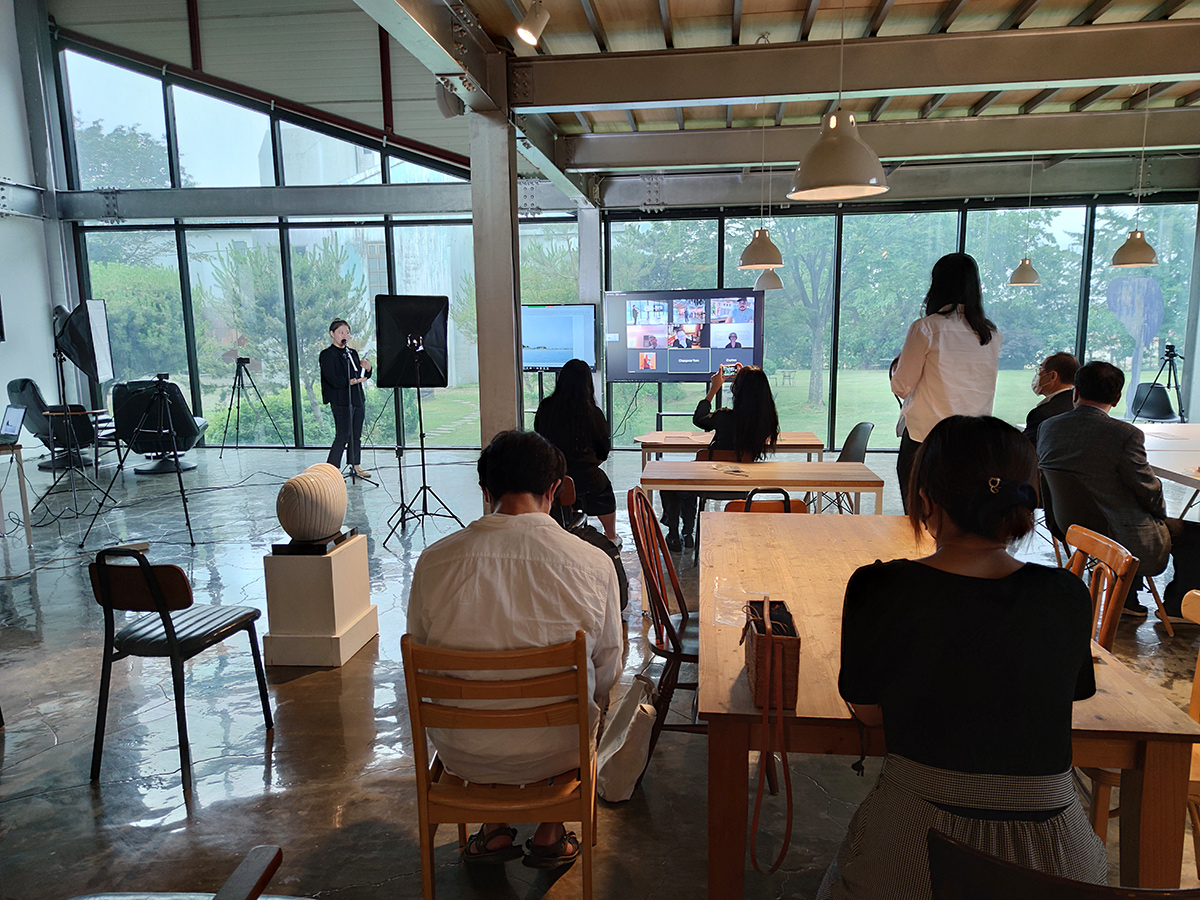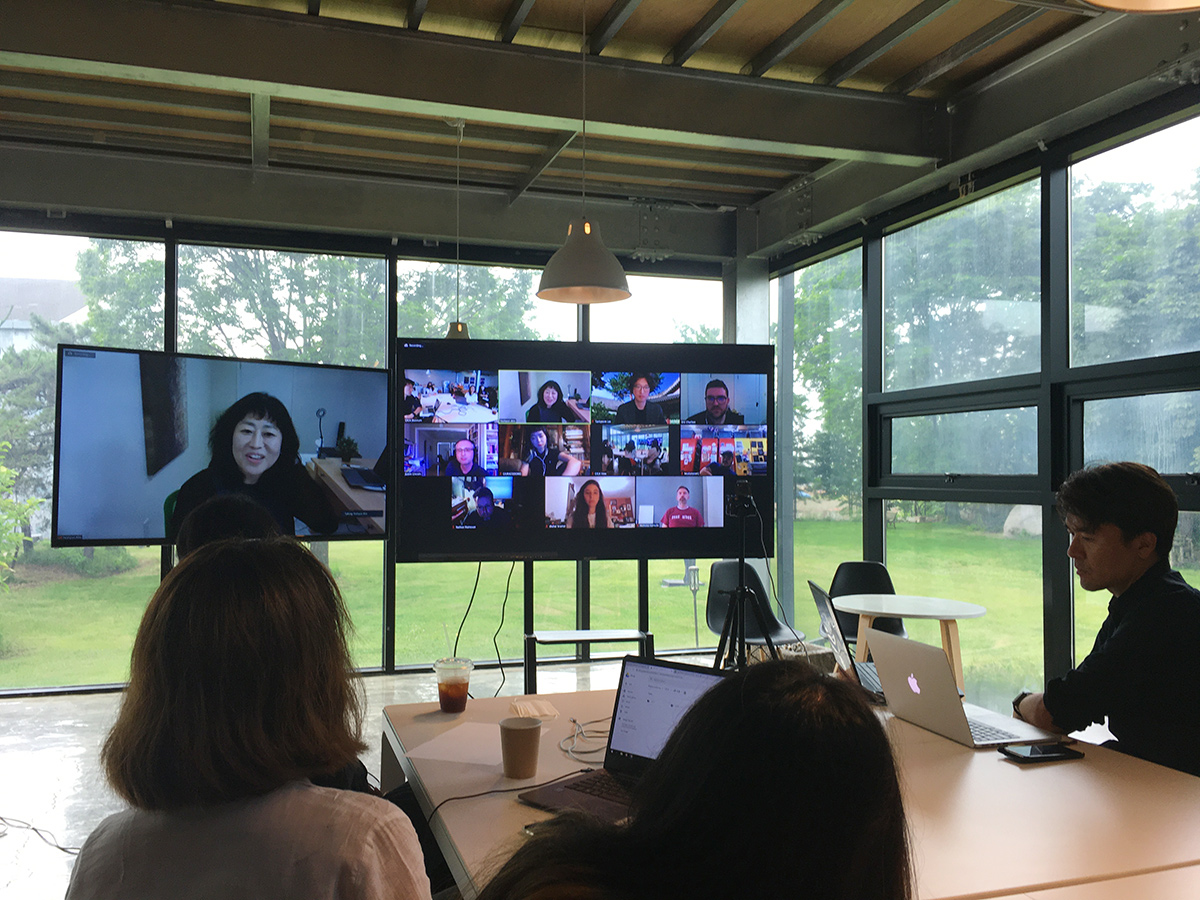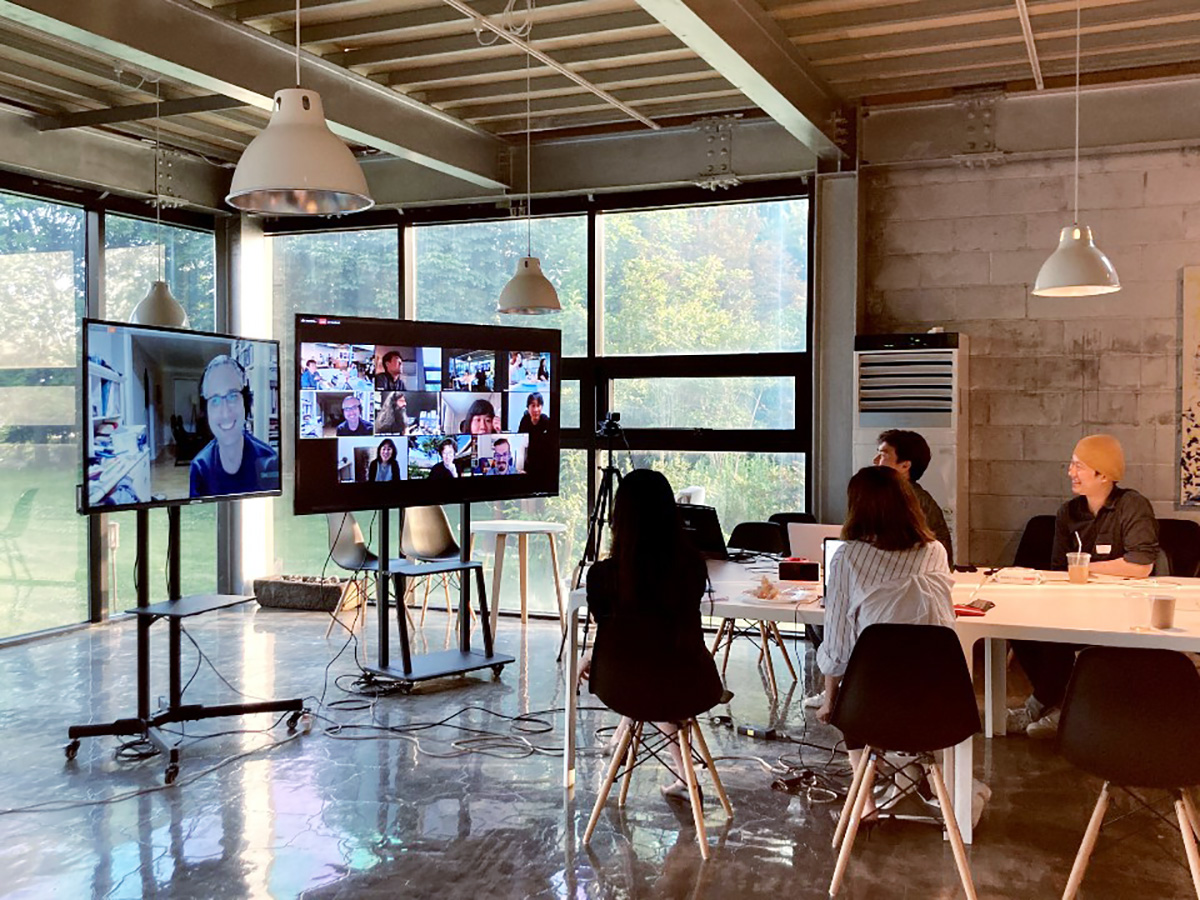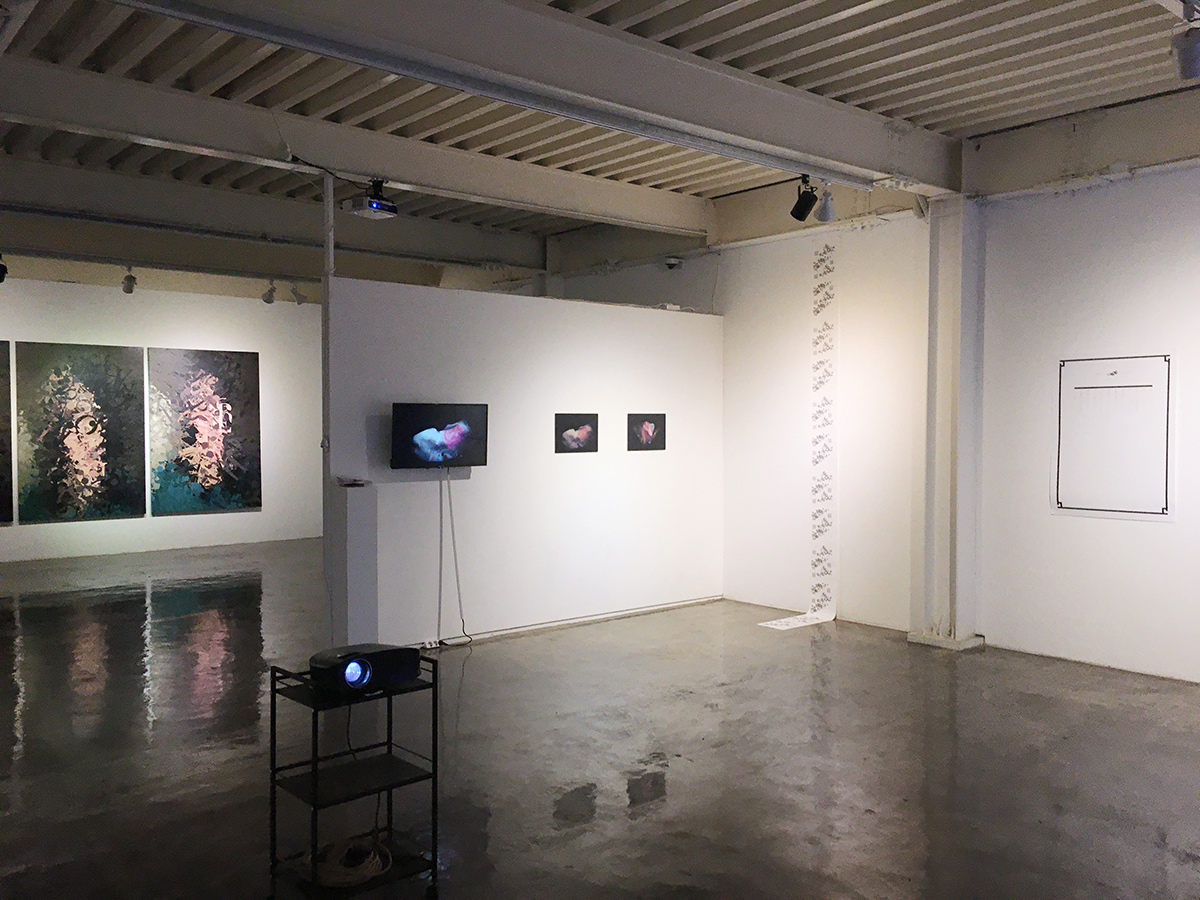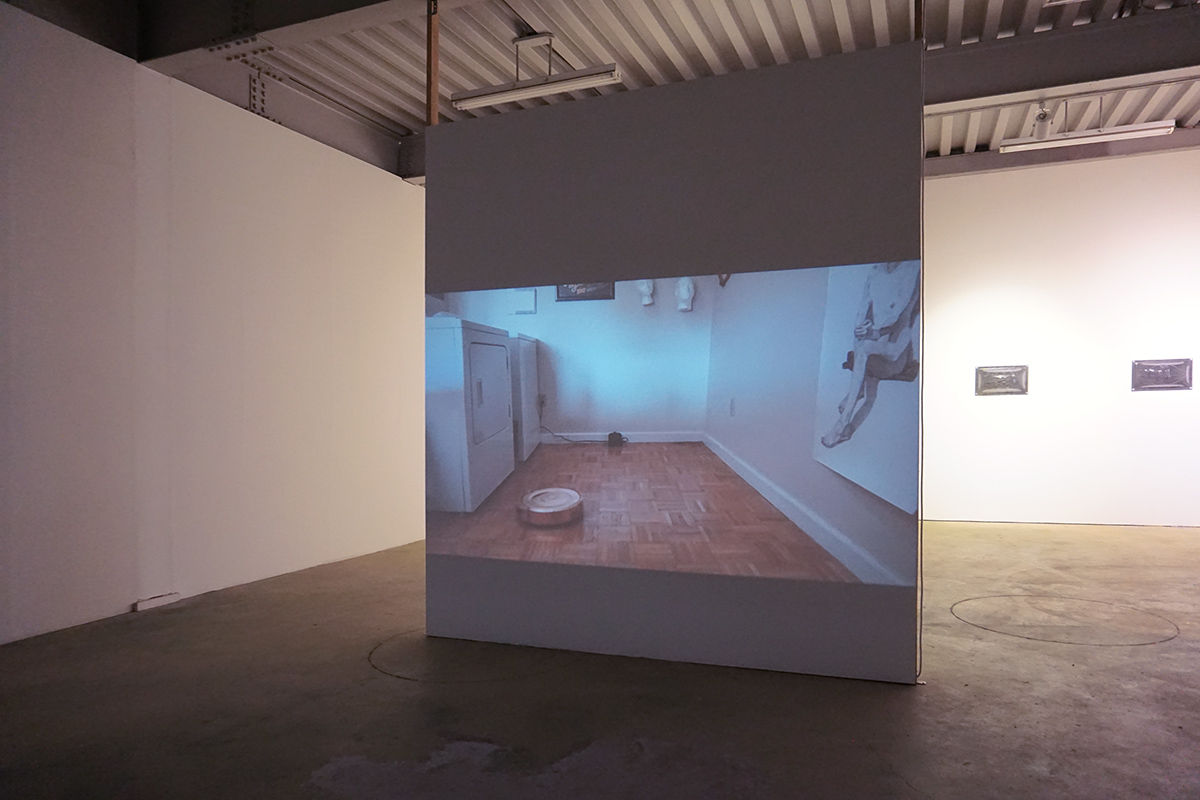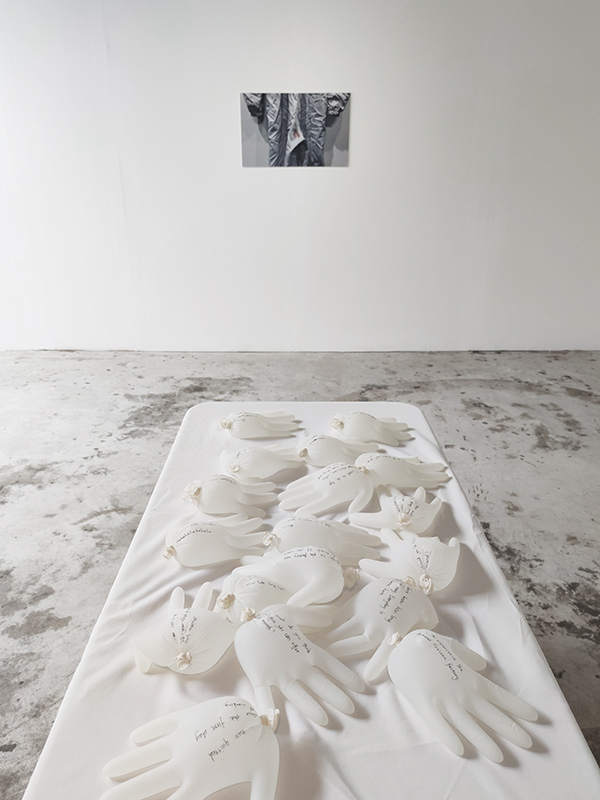A New Normal on Our Tomorrow
by Yujin Kim
Despite this challenging situation, fortunately, CICA NMAC 2020 was placed from the 18th to 21st in June. The whole process of events was conducted via Zoom, software for video conferencing, and also broadcasted live via Youtube. Starting from the brief introduction of artists on the first day of the conference, artists and participants presented their artworks and had a variety of conversations on them sharing their own ideas.
Most of the artists who could not have managed to visit the venue participated in the conference on screen; which is vividly contrasted to the scene of the last year’s event. Though the process and the atmosphere of the conference have changed dramatically in an unexpected way, this experimental meeting has brought several interesting conversation and debate on new media arts, especially in the light of the current situation provoked by the pandemic.
Artists often use new media to create something different. Yeohyun Ahn adopts typography to create self-portraits conveying coded thoughts, feelings and personality. Taekyeom Lee explores unconventional materials using digital methods, 3D printing, in order to create tangible typography and ceramics. Changwoo Yoon, an AI scientist and artist, introduces a new insight on the new media and art by pursuing the convergence of the art and neuroscience to create artworks based on the scientific facts. Lucy Winnington researches the biological materials as new media and connects a traditional concept, Uncanny valley. GIURACODOMO, a Japanese artist and graphic designer, make artworks in prints, video and sounds based on the Japanese tradition, Shinto religion, and human emotions. Heesoo Agnes Kim and Sungil Daniel Kim present Uncertain Pixel Project, a collaboration between performance-based video art and computer engineering.
Otherwise, others observe the new technology as a new form of environment. Eric Charlton focuses on the lack of human understanding on a cosmic scale to the minutiae of the everyday correlated to the consumable media. Heui Tae Yoon also describes the human nature in this era of machine and technology within the religious background. Nicholas Kersulis questions the essential objectivity of system -i.e., internet- itself within the non-physical spaces. He recently conducted a project Good-for-nothing, which investigates the slipperiness of digital images, collaborating with Nathan Matteson, a designer who fiercely ignores the common boundaries amongst disciplines.
Modern technology and concepts permeate our lives and make changes as well. Sora Woo’s works, Piled Archives, highlights the mundane and unconscious activity, taking loads of selfies, and discovers the time passing by, and the physical and spiritual perspective of “irreversible”. Mengda Zhang takes attention to the relationships among the most ordinary people such as factory workers. Her sentimental performance weaves the threads between individuals to be connected. Shahar Kramer investigates the significant shapes of relationship, intimacy and closeness in the contemporary society of capitalism. In the meantime, Haya Sheffer suggests Internal Durée, intentionally resting physical and psychological activity, and reminds us of the invaluableness of having mediation and self-reflection.
Even though it was forecasted that some technological and communicational issues were unavoidable during the conference going on for several hours, there were other unexpected problems; which might suggest new perspectives on our close future. The voices are less clearer so that the communication should have been precisely in a one-way direction. Besides, it is still concrete truth that our bodies are indeed located in the different time zones and spaces in our way of attitude. We share the atmosphere, and physical and psychological attachment or communication less than what we used to do. Rather than other participants, our bodies are pertinent to our friends, partners and dogs or cats who are physically staying together at the moment; which obviously reduces the flow to the virtual communication. Again, our experiences are being fragmentised inevitably (ibid.).
We have tended to be positive towards the new technology. Now, a question rises. Can technology indeed overcome the physical limitation? Can we shorten the distance towards others not only in physically but also emotionally? Can virtual experience fully replace the embodiment? If not, what would we be able to do in upcoming changes in the way of experience? In addition to the meaningful discussions on the art and New Media, it was such a great opportunity to think about what New Media has been and will be able to do.
Bibliography
Wegentstein, B. (2010). Body. In: Hansen, M. B. N. and Mitchell, W. J. T. ed. Critical Terms for Media Studies. Trans. Jeon, H. Paju: Mijinsa, pp. 43-60.
A Dialogue on Technology and the Boundaries of Art
by Heewon Lee
The 2020 New Media Art Conference was not limited to sharing each participating artist’s works, but was also a platform to discuss where we are headed in the art world, and in a broader sense, the world. Within the many compelling dialogues, one of the most heated — if not the most heated — conversations during the conference was sparked by Chang Woo Yoon’s presentation. An artist with a computer science background, Changwoo finds parallels between the human visual system and digital systems, claiming that this is the very foundation of integrating art and cutting-edge technology. Through his pieces such as the ‘Primitive Sensibility’ series, Changwoo explores the concept of ‘seeing,’ what it is, and how it is processed. He presented a number of oil paintings accompanied by a video piece rooted on the question of how humans perceive the world.
Following Changwoo’s presentation was a heated debate on his art practice. Artist YeoHyun Ahn asked Changwoo why he used conventional media (oil painting) when he is exploring such radical concepts and how he plans to bridge the gap between his concept and final outcome. In addition to her inquiry, Ahn commented that it may be hard for future generations to fully appreciate the complex concepts behind his works without an elaborate explanation and suggested that Yoon create more interactive pieces. Yoon responded to Ahn’s questions and comment by stating how to address the problems rooted in required context and background knowledge for understanding the meaning behind a piece of art. The first method, according to Yoon, is to explain the theory and context of the piece at the gallery, and the second way is to make the concept itself simple. Changwoo’s works, as he claims, suits the first method, and he added that the requirement of verbal explanation applies equally to both traditional and new media art. This dialogue between Changwoo and Yeo Hyun raises a number of questions: Can traditional media convey radical concepts? How is art perceived by future generations, and do all great art need to be appreciated by them? Should the concept of a piece of art be visually evident?
The debate on Changwoo’s art practice and the implications of it gradually shifted to a conversation on art in the era of artificial intelligence. The participants of the conference discussed the extent of authorship artificial intelligence should have in an artwork it was employed to create when it reaches a state where it can think for its own. While many stayed cautious in terms of how to define this, artist Taek Yeom Lee voiced out that the authorship of art perhaps depends on the decision making process of the artist using the technology. Perhaps, we are repeating our history where we question whether visuals created using a new type of medium should be considered as art, as we have done so with once-new media such as photography and videography.
Conversations on art and its relations to cutting edge technology brings us back to the fundamentals of art, what it is, and where it is headed. These questions have not only been the theme of this specific discussion, but was also a backbone of the whole conference. As artists, critics, and audience members, these questions will always be pivotal points to address when making, evaluating, and appreciating art.
Into the Clouds
by Soyeon Park
From 18th to 21st of June 2020, CICA New Media Art Conference (NMAC) 2020 opened in CICA museum in Gimpo, South Korea. Followed by the guidance from Gimpo City Hall and Korea Centers for Disease Control and Prevention (KCDC), and in the middle of the global pandemic crisis (Covid-19), the conference was successfully conducted with cutting-edge devices to devise remote meetings.
The conference began with an opening party on the first day of the event, 18th of June, and international artists and presenters participated in the conference online in the following days. During this period, solo exhibitions for each of the following artists were held in the museum; Yeohyun Ahn, Janna Ahrndt, Eric D. Carlton, GIURACODOMO, Shahar Krramer, Taekyeom Lee, Haya Sheffer, Sora Woo, Changwoo Yoon and Mengda Zhang.
The overall conference consisted of artists and presenters who are working very closely with the notion of new media and technology with art to discuss the ideas of how the art industry is facing new emerging technologies and also to share how this global crisis is affecting the art at the moment.
On the first day of the main conference, 19th of June, 7 artists; Yeohyun Ahn, Janna Ahrndt, Eric D, Menda Zhang, Shahar Kramer, GIURACODOMO and Haya Sheffer presented their artworks and related topics, moderated by Justin Lincoln, and one team – Nicholas Kersulis & Nathan Matteson – participated as presenters. On the second day, 20th of June, three artists; Takyeom Lee, Changwoo Yoon and Sora Woo shared their works and thoughts, and three teams; Lucy Winnington, Heesoo Agnes Kim & Sungil Daniel Kim and Heui Tae Yoon participated as presenters.
Due to the unprecedented global crisis, the majority of art events including exhibitions, conferences, programs and even small contracts were inevitably cancelled. However, the use of significant developed technological skills with cutting-edge devices, for instance, live streaming, video conferencing, and social media tool, enabled these blocked connections to link worldwide, and this led the possible conference at CICA museum. NMAC 2020 addressed an important discourse of new media art in the digital era around the world and showed the potential possibilities of remote events in the art industry.
접촉을 넘어서
by 김은정
잠깐의 유행병으로 지나갈 줄 알았던 코로나 사태가 반년이 넘게 지속되는 동안 많은 이들의 생활 방식이 변화했다. 정부에서는 회합을 되도록 피하라는 지침을 내렸으며, 대다수의 교육 기관에서는 불가피하게 온라인으로 교육을 지속하는 방편을 택했다. 생계가 달려있는 직업의 영역에서도 예외는 아니었다. 가능한한 모든 시스템을 코로나 이전의 상황과 비슷하게 유지하고자 했지만, 감염을 피하기 위해서는 사람 사이의 접촉을 최소화하는 것이 필수적이었기에, 이전의 우리라면 상상치도 못 할 생활 방식을 택하게 되었다. 어디를 가든 마스크를 써야 했으며, 타인과의 접촉을 피해야 했고, 가벼운 기침 소리에도 눈살을 절로 찌푸리게 되었다. 고작 6개월 남짓한 짧은 기간동안 이전에 ‘접촉’이 가졌던 의미들은 지워졌으며, 이제 ‘접촉’이란 피해야 하고 조심해야하는 것, 우려되는 것으로 변질되었다. 엄격히 말해 변질되었다기보다 접촉이 가진 부정적인 측면들이 대두되기 시작했다. ‘접촉’ 방식의 변화가 요구되는 시기가 찾아온 것이다. 이런 시기에 뉴미디어 아트 컨퍼런스란 어쩌면 새로운 ‘접촉’ 방식에 대한 답을 귀띔해줄 절호의 기회인 것처럼 보였다.
이번 아트 컨퍼런스는 온라인으로 진행되었으며, 컨퍼런스를 통해 세계를 무대로 활동하고 있는 15팀의 아티스트를 만나볼 수 있었다. 첫 날 오프닝 파티를 시작으로, 이틀 간 아티스트들이 각자의 작품을 소개하고 이에 대해 토론하는 시간을 가졌으며, 이를 바탕으로 콜라보레이션 프로젝트가 진행되었다. 뒤 이은 4일 째에 함께한 브런치를 끝으로 공식 일정은 모두 종료되었다.
CICA 미술관의 아트 컨퍼런스는 코로나 팬데믹이라는 혼란한 상황에도 불구하고 진행되었다는 자체로 의의를 가진다. 코로나 사태 속에서도 인생은 계속된다. 그렇지만 이전과는 다른 형태로. 인생이 계속되듯 예술 여기 계속해서 논의 되어야한다. 하지만 그 역시 이전과는 다른 형태로. 뉴미디어 아트 컨퍼런스를 인터넷 화상회의로 진행했다는 것은 일종의 상징적인 행위예술처럼 보이기도 한다. 너무나 탁월하게 들어맞지 않는가. 뉴미디어 아트에 대해 토론하는 뉴미디어 아티스트를 뉴미디어 플랫폼을 통해 만나보고 있다는 것이. 안타깝게도 코로나 사태로 인해 예년처럼 직접 아티스트들을 초대할 수는 없었으나 그 대신 ‘ZOOM’이라는 화상회의 플랫폼을 소통의 장으로 삼았다. 우리와 다른 공간에 놓인 사람들과 미디어를 통해서 교류한다는 것은 양자가 동시에 존재할 수 있는 새로운 공간을 창조하는 것과 같다. 큰 스크린 앞에 옹기종기 모여 앉아 지구 반대편에 있는 아티스트들을 마주하며 비로소 새로운 ‘접촉’의 장이 열렸음을 실감했다.
코로나 사태와 맞물려 접촉의 의미를 되새기며, 우리는 이러한 의문을 제기할 수 있다. 관람객과 작품 사이의 상호작용을 통해서 작품은 새롭게 해석되며, 그 의미는 더욱 풍부해진다. 따라서 양자의 접촉은 오늘날 예술에서 중요하게 작용하며, 더 이상 생산자와 소비자로 단순히 구분할 수 만은 없게 되었다. 하지만 관람객 앞에 작품이 놓여있지 않다면 어떻게 되는 것일까? 관람객이 보는 것이 또 다른 미디어를 거친 작품의 환영일 뿐이라면? 그렇다면 이 경우에도 작품과 관람객이 동시에 공유하는 공간이 존재하며, 이를 근거로 작품과 접촉했다고 말할 수 있는가?
접촉 시의 공간성, 그것은 유비쿼터스이다. 앞서 말했듯 본 아트 컨퍼런스가 미디어 플랫폼을 이용하여 세계 곳곳의 아티스트와 교류할 수 있는 새롭고 고유한 공간을 창조해냈다는 점에서 접촉시의 공간은 어디에나 존재할 수 있다는 가능성을 보여주었다. 하지만 이 공간은 오직 컨퍼런스 기간 동안만 일시적으로 존재할 뿐이기에, 존속하지 않는 것이라고 말할 수 있다. 그럼에도 본 아트 컨퍼런스를 통해 이미 일시적으로 존재하는 공간을 매개하는 동시에, 원거리에서도 기능하는 접촉의 가능성을 확인했기 때문에, ‘접촉’이라는 개념에서 요구되는 항구불변한 공간성의 증명은 불필요한 것처럼 보이기도 한다. 결국 작품과 관람객 사이에 요구되는 접촉의 공간성이란 동시에 존재할 수 있는 실제적 공간의 여부에 대한 의문이라기보다, 미술관이나 박물관 같은 전통적인 공간을 매개하지 않는다고 해도 과연 작품이 관람객에게 가닿을 수 있는가하는 문제이기 때문이다. 본 컨퍼런스에서 예술은 미디어를 통하여 새로운 공간성을 창조해냈음을 보여주었으며, 이는 곧 공간에 구애받지 않는 예술의 접촉 가능성에 대한 증명이기도 했다. 고립된 예술이란 자폐적이며 그 속에는 소통이 부재한다. 놀랍게도 CICA 아트 컨퍼런스에서 우리가 목도한 것은 찾아 마지 않던 소통의 장이였으며 미디어를 통해 공유되고 뻗어나가는 예술이었다.

